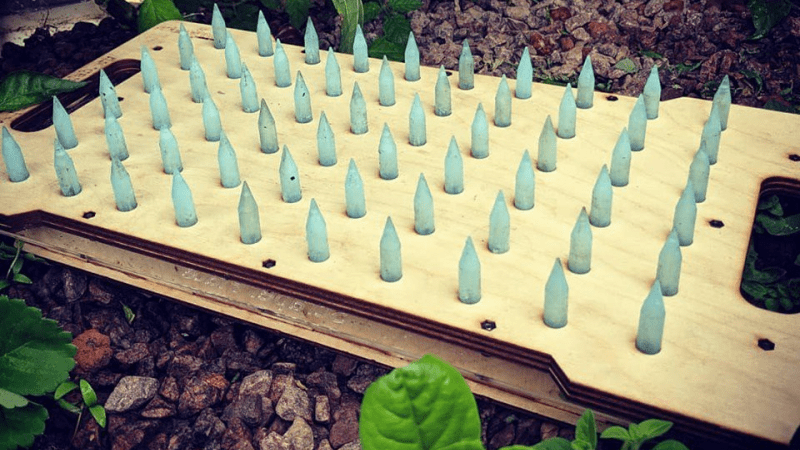One of the best things about 3D printers and laser cutters is their ability to produce specialized tools that steal time back from tedious processes. Seed sowing is a great example of this. Even if you only want to sow one tray with two dozen or so seeds, you still have to fill the tray with soil, level it off, compress it evenly, and poke all the holes. When seed sowing is the kernel of your bread and butter, doing all of that manually will eat up a lot of time.
There are machines out there to do dibbling on a large scale, but [Michael Ratcliffe] has been dabbling in dibbling plates for the smaller-scale farm. He’s created an all-in-one tool that does everything but dump the soil in the tray. Once you’ve done that, you can use edge to level off the excess soil, compress it with the back side, and then flip to the bed-of-nails side to make all the holes at once. It comes apart easily, so anyone can replace broken or dulled dibblers.
[Michael] is selling these fairly cheaply, but you can find all the files and build instructions out there in the Thingiverse. We planted the demo video after the break.
More into micro-greens? 3D printing can feed that fixation, too.

















I had no idea that “dibbler” had a meaning unrelated to sausage inna bun. Guess you learn something every day if you’re not careful.
I could plant them for less, but that would be cutting me own throat
Guaranteed to contain real wood
I had no idea that people call things ‘dibblers’ – to me this is a ‘dibber’ but I can’t find any strong source for where the two different terms are used.
I may have made the word up…. :D
No. ‘Dibble’ boards are a common term in the horticulture industry. And the end-users often refer to then as ‘dibblers.
I have a client (probably the largest floriculture grower of cacti and succulents in the Americas) that uses dibble boards in his seed flat production line that are 1.5m x 2m (they do not use the standard 1020s). Last that I looked, this company had over 100 different dibble board types/sizes, and over 10,000 individual dibble boards. The point being, that for planting seeds or seedlings or plugs, there is a specific shape and size and spacing that will enable the best survival and growing rates. And this would have been the interesting thing to discuss.
The material used in the discussed dibble plate is fine for hobby use, but do not expect to get much life out of it in a production environment.
Hi Brian, good to know I didnt dream the word up.
Could you elaborate on the material use limiting the life [any recommendations]? Im aiming at getting many good years of use from the board, I dont expect it to be used 24/7 a few hours a week.
I assume that when yo say “there is a specific shape and size and spacing..” this implies that these parameters change per each plant type? and thus the need for so many different boards in a large facility?
Dibbler is a corruption of the English word dibber which is what is being talked about here. :)
It’s good to use a tool if this is something you have to do more than once in a fortnight. Otherwise there will be another spikey plate in your toolshed that hardly ever sees any use. Putting holes in loose soil is not a difficult task even if you do them one by one, and there is no need for precision.
I would also like to see one with an adjustable pattern up to 40x40cm for outdoor planting.
Indeed for someone sowing a few trays of seeds a year its not that useful, I made this for small farmers like myself who are seeding a few hundred to a thousand seeds per day :)
There is also a drop seeder to go with the dibbler that I should post on thingiverse, when your using a vacuum seeder/drop seeder the placing of the holes needs to be relatively precise.
I have been thinking of a similar tool for planting onions/garlic outside, what are you thinking of planting with the 40×40 one?
Is there some convenient way to adjust the depth? The current depth is way too deep for most common crops used.
Generally you don’t want more than 3-4 seed diameters of soil over your seed. It wastes seed energy getting to the surface and you’ll get delayed starts and risk vulnerable or stunted plants which, since this is for business, matters.
Hi, We are using coco fibre that needs compressing before dibbling…. meaning the medium after compression is well below the edge of the planter and deep spikes are needed for us.
Its open source so you can edit the spikes as you see fit, but I have just updated the thingiverse files to include a range of spikes that may suit your needs?